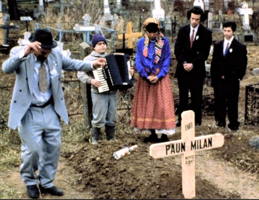
|
The Society of Folk Dance Historians (SFDH)
Gadjo Dilo
[
Home |
About |
Encyclopedia | CLICK AN IMAGE TO ENLARGE |

|
BACKGROUND
Information: Gadjo Dilo, a Romani film.
COMMENTS
The Romani peoples are so little understood that any depiction of them in the arts has unusual power to perpetuate myths, create new ones, or perhaps, even to dispel some of the fables and fantasies that still surround them. In the film, Director Tony Gatlif has navigated the seas of cultural conflict with great sensitivity and humour.
 In the "Gadjo Dilo," three cultures meet; a young Parisian, (Stéphane, in search of a singer recorded by his dead father), the Kalderash Rom, (whose village he lands in), and the Romanian villagers. (The Kalderash are one of the major groups of Roma living in Romania, and specialize in metalwork.) Stéphane, in the quest for the singer of his father's favourite song, finds himself in a Romanian village after curfew. Izidor, a Roma musician, is drinking away his pain in the square – his son has just been taken to prison. To the Roma, jail is like death; to be separated from the group is like death. Izidor accepts Stéphane as sent by God (we have experienced this acceptance of strangers in Turkey and Transylvania. One doesn't question why a stranger is on your doorstep, you simply offer all the hospitality you can) and, as is the custom, installs him in his own bed. (No one should be left to sleep in the street, and a guest always has the best bed.)
In the "Gadjo Dilo," three cultures meet; a young Parisian, (Stéphane, in search of a singer recorded by his dead father), the Kalderash Rom, (whose village he lands in), and the Romanian villagers. (The Kalderash are one of the major groups of Roma living in Romania, and specialize in metalwork.) Stéphane, in the quest for the singer of his father's favourite song, finds himself in a Romanian village after curfew. Izidor, a Roma musician, is drinking away his pain in the square – his son has just been taken to prison. To the Roma, jail is like death; to be separated from the group is like death. Izidor accepts Stéphane as sent by God (we have experienced this acceptance of strangers in Turkey and Transylvania. One doesn't question why a stranger is on your doorstep, you simply offer all the hospitality you can) and, as is the custom, installs him in his own bed. (No one should be left to sleep in the street, and a guest always has the best bed.)
Stéphane, the crazy stranger (Gadjo is the masculine of 'non Roma' so it means foreigner) does really crazy things like playing with children in the snow, cleaning Izidor's room, and continually asking for Nora Luca – the singer of his father's song. Cleaning the room can be seen as crazy on several levels. In Rom society, men and women have clearly defined roles. Cleaning rooms is very much the work of younger women, so his actions are incredibly funny, particularly to these younger women. It is also insulting to suggest that Isidor's room is not kept well enough. Looking for one singer is also strange when there is music all around you. Everybody sings and there are many good singers.
Despite this craziness he manages to win the heart of Sabina. Sabina had been to Belgium with her husband to work as a dancer, but had not liked it (or him) and had returned to the village. Rom society is very closed when it comes to marriage. If you marry a gadjo/gadje you are out; no longer considered Roma. The fact that she is a divorcee, so somewhat "spoiled goods," makes it just believable that the village would accept a romance with a gadjo.
Things turn sour when an accidental death provides the catalyst for the Romanians to destroy the Rom village. Unfortunately this is something that has been happening since the revolution ended Ceauscescu's dictatorship, with many Rom villages being torched.
Director, Algerian born Tony Gatlif, has allowed the Rom to speak for themselves through their roles in the film. "People are afraid of the Rom who make fun of everything and are afraid of none. I wanted only non-professionals to play their proper roles in this film with Romain and Rona (Stéphane and Sabina). It is my most complete film, not in terms of the images, but in terms of sincerity. The poetic nature of the film is woven by life itself. When I arrived in Balteni, I found extraordinary people without a care for Romania nor France! Balteni is located 60 kilometres from Bucharest."
Using real people in the film who say and do real things is a powerful technique. In "Time of the Romani," a film by Serbian director Emir Kusturica, Rom people also played themselves giving tremendous strength and veracity to the action. However, in that film the 'real' bits were interspersed with 'unreal', bizarre and often violent scenes. I found that juxtaposition exploitative and abusive. Furthermore, the credit for the music in 'Time of the Romani' was claimed by the musical director Bregovitch, despite all the tunes coming from the Romani repertoire.
I had to forgive some scenes in 'Gadjo Dilo' where little bits of unreality jumped in; Izidor miming the violin playing with little connection to the soundtrack; unattended fires next to big piles of straw; Stéphane and Sabina running naked through a Romanian forest. But there are some lovely moments: the astonishment of the locals at the condition of the Frenchman's shoes; the father of the bride wielding an axe and refusing to give up his daughter before accepting the drink from the grooms party; Stéphane insisting on quiet for his dat recordings, and the 'crazy foreigner' cleaning the room. (This got the biggest laugh from the Roma in the cinema.) Izidor Serban is superb, presumably basically playing himself. Director Tony Gatlif says of him "he had never thought for a moment that, if he played a drunk, he shouldn't really be drunk." The sensual, sensational Rona Hartner, who won the 1997 Best Actress Award at the Locarno Film Festival, is so good in her role as the dancer Sabina, that the Roma in the audience are convinced she is one of theirs. She is in fact Saxon, another of Romania's minorities. (They were brought over to Transylvania, north of Wallachia where the film is shot, as "Gästarbeiters" some hundreds of years ago.)
A day before the end of shooting, director Tony Gatlif still didn't know how the film was going to end. "I'm waiting for something, a sign that hasn't come. I don't want to end like in the movies. Do you understand? In my film, no one wins: neither Stéphane, the Romani, the Romanians, nor me or Romain Duris (the actor who plays Stéphane). I can feel we're going to come off badly." The ending he found has Stéphane destroying and burying his dat recordings, perhaps a rejection of his own exploitation of the Roma. Or perhaps he has accepted the Roma view that there is good music all around.
The last word should belong to a friend who saw the film with me. At first she refused to believe that those people still live like that in this day and age, in such poverty, and then she became very cross because people might think that she, being from one of the Rom groups in Macedonia, could be the same as the Roma in the film!
Most Roma live in houses, and wherever they have been allowed to, they have settled. This does not fit with 'the unfettered traveller' myth, one of the two favourite myths about 'Romani'. Similarly, the other favourite myth, that of "the petty thief" does not fit with Romanian police statistics which show that Roma commit less crime per capita than other ethnic groups. So when we use the word 'Rom', let's remember we are talking about real peoples, real cultures.
–Rob Bester
Rob Bester has been learning and playing traditional dance music from around the Balkan region for many years. His band XENOS specializes in Roma music from Macedonia, and their drummer, Fuat Sazimanoski, is a Rom from the Egipchani of Ochrid, Macedonia.
DOCUMENT
- Rom, an article.
This page © 2018 by Ron Houston.
Please do not copy any part of this page without including this copyright notice.
Please do not copy small portions out of context.
Please do not copy large portions without permission from Ron Houston.